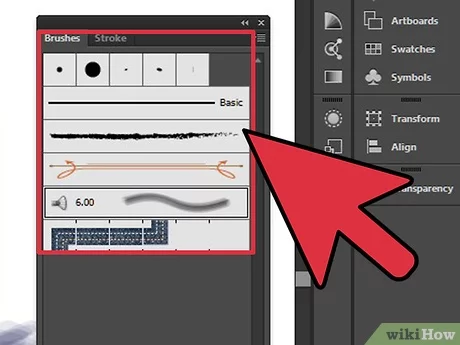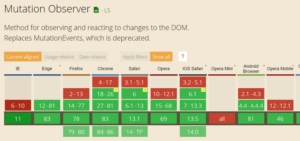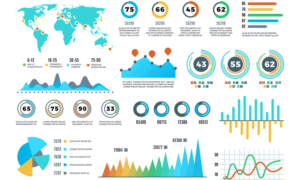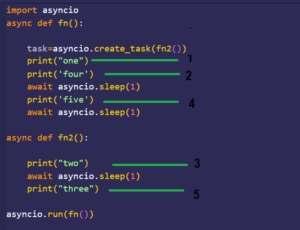Mastering Creativity: A Comprehensive Guide to Utilizing the Art Brush Tool in Adobe Illustrator

Introduction:
In the realm of digital design, Adobe Illustrator serves as a versatile platform for artists, designers, and creators to unleash their creativity and bring their visions to life. Among its extensive array of features, the Art Brush Tool stands out as a powerful instrument, providing users with the ability to create dynamic, expressive, and visually captivating artwork with ease and precision. Whether you’re a seasoned illustrator, a graphic designer, or an aspiring artist, mastering the art of using the Art Brush Tool in Adobe Illustrator opens up a world of possibilities for creating stunning illustrations, intricate patterns, and captivating designs. In this comprehensive guide, we’ll embark on a journey to explore the techniques and tools needed to master the Art Brush Tool, empowering you to infuse your designs with depth, texture, and personality.
Chapter 1: Understanding the Art Brush Tool
At its core, the Art Brush Tool in Adobe Illustrator is a transformative feature that allows users to apply brush strokes along paths, shapes, and objects, creating fluid and expressive artwork. Unlike traditional brushes, which rely on static shapes and patterns, the Art Brush Tool enables users to define custom brush shapes, textures, and dynamics, allowing for endless creativity and versatility in their designs. Understanding the principles of using the Art Brush Tool, including brush settings, stroke options, and brush libraries, lays the foundation for effectively harnessing its power to create stunning illustrations and designs.
Chapter 2: Navigating the Art Brush Tool Options
Before delving into the creative process, it’s essential to familiarize yourself with the various options and settings available for the Art Brush Tool in Adobe Illustrator. The Art Brush Tool panel provides a range of options for customizing brush shapes, textures, and dynamics, such as brush size, angle, and pressure. Experiment with adjusting settings such as brush scale, flip along, and stretch to fit stroke length to achieve the desired effect. Additionally, explore the Art Brush Tool preferences in the Adobe Illustrator settings to customize default settings such as brush definition and smoothing.
Chapter 3: Creating Custom Art Brushes
With your document open in Adobe Illustrator, it’s time to start creating custom art brushes using the Art Brush Tool. Experiment with drawing shapes, patterns, and textures using vector shapes, paths, and objects, then convert them into custom brushes using the New Brush dialog. Practice adjusting settings such as brush scale, direction, and spacing to control the appearance and behavior of your custom brushes, allowing for endless possibilities for creating unique and visually striking artwork. Consider creating brushes that mimic traditional media such as ink, paint, or chalk, or experiment with abstract shapes and patterns to add depth and texture to your designs.
Chapter 4: Applying Art Brushes to Paths and Objects
Once you’ve created custom art brushes, it’s time to start applying them to paths and objects in your artwork. Select the path or object you want to apply the brush stroke to using the selection tool (V), then activate the Art Brush Tool from the toolbar or by pressing Shift + B on your keyboard. Choose the desired brush from the brush library or select a custom brush from the brushes panel, then click and drag along the path to apply the brush stroke. Experiment with adjusting settings such as brush size, scale, and spacing to control the appearance and intensity of the brush stroke, allowing for precise control over the look and feel of your artwork.
Chapter 5: Exploring Art Brush Effects and Techniques
In addition to applying basic brush strokes, Adobe Illustrator offers a variety of advanced techniques and effects for creating dynamic and visually captivating artwork using the Art Brush Tool. Experiment with combining multiple brushes and strokes to create complex patterns, textures, and effects, layering strokes and adjusting blending modes to achieve interesting visual effects. Use techniques such as pressure sensitivity, tilt, and rotation to create expressive and dynamic brush strokes that add movement and personality to your artwork. Explore techniques such as scatter brushes, pattern brushes, and calligraphy brushes to further customize and refine your brush strokes, adding depth and dimension to your designs.
Chapter 6: Incorporating Art Brushes into Illustrations and Designs
Once you’ve mastered the basics of using the Art Brush Tool, it’s time to incorporate art brushes into your illustrations and designs in Adobe Illustrator. Experiment with using art brushes to create illustrations, logos, typography, and patterns that showcase your unique style and vision. Practice combining art brushes with other design elements such as colors, gradients, and textures to create visually compelling compositions. Consider using art brushes as accents or embellishments to add depth and visual interest to your artwork, or use them as the primary focus to create bold and expressive designs that command attention.
Chapter 7: Fine-Tuning and Refining Art Brush Effects
Once you’ve incorporated art brushes into your artwork, take time to fine-tune and refine the effects to achieve the desired look and feel. Experiment with adjusting settings such as brush size, scale, and spacing to control the appearance and intensity of the brush strokes. Use the appearance panel and graphic styles in Adobe Illustrator to apply gradients, patterns, and textures to brush strokes, adding depth and visual interest to your artwork. Pay attention to details such as composition, balance, and focal points to ensure a cohesive and visually compelling result.
Chapter 8: Saving and Sharing Artwork with Art Brushes
Once you’re satisfied with your artwork in Adobe Illustrator, it’s important to save and share your designs for sharing or distribution. Save your Illustrator document in a compatible file format, such as AI or PDF, to preserve the vector properties of your artwork. If you’re creating artwork for web or screen-based applications, consider exporting it as an SVG file for scalability and compatibility with web browsers. For print-based projects, export your artwork as a high-resolution raster image in formats such as JPEG or PNG.
Conclusion:
Mastering the Art Brush Tool in Adobe Illustrator is a journey of exploration and experimentation, offering endless possibilities for creating dynamic, expressive, and visually captivating artwork. By understanding the techniques and tools needed to navigate the Art Brush Tool options, create custom art brushes, apply art brushes to paths and objects, explore art brush effects and techniques, incorporate art brushes into illustrations and designs, fine-tune and refine art brush effects, and save and share artwork with art brushes, you’ll be able to create stunning designs that captivate and inspire viewers. So grab your stylus, set your sights on the canvas, and let Adobe Illustrator become your trusted ally for infusing your designs with depth, texture, and personality.




